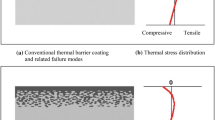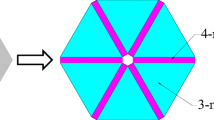Abstract
Functionally Graded Materials (FGMs) have been developed as super-resistant materials for propulsion systems and airframe of space-planes in order to decrease thermal stresses and to increase the effect of protection from heat. It has been experimentally observed that surface cracking in FGMs is the most common failure mode of a metal-ceramic FGM when it is subjected to a thermal shock. Therefore, it is very important to consider the thermally induced fracture behaviors of FGMs. In this paper, a functionally graded material strip containing an embedded or a surface crack perpendicular to its boundaries is considered. The graded region is treated as a large number of single layers, with each layer being homogeneous material. The problem is reduced to an integral equation and is solved numerically. Unlike most of the existing researches, which considered only certain assumed material distributions, the method developed in this paper can be used to investigate functionally graded materials with arbitrarily varied material properties.
Similar content being viewed by others
References
Erdogan, F. (1995). Fracture mechanics of functionally graded materials. Composites Engineering 5, 753–770.
Erdogan, F. and Ozturk, M. (1995). Periodic cracking of functionally graded coatings. Int. J. Engng. Sci. 33, 2179–2195.
Erdogan, F. and Rizk, A.A. (1992). Fracture of coated plates and shells under thermal shock. Int. J. Fract. 53, 159–185.
Erdogan, F. and Wu, B.H. (1996). Crack problem in FGM layers under thermal stresses, J. Thermal Stresses 19, 237–265.
Jin, Z.-H. and Batra, R.C. (1996). Stress intensity relaxation at the tip of an edge crack in a functionally graded material subjected to a thermal shock. J. Thermal Stresses 19, 317–339.
Jin Z.-H. Noda, N. (1994). Edge crack in a nonhomogeneous half plane under thermal loading. J. Thermal Stresses 17, 591–599.
Jin, Z.-H. and Paulino, G.H. (2001). Transient thermal stress analysis of an edge crack in a functionally graded material. Int. J. Fract. 107, 73–98.
Kokini, K. and Takeuchi, Y.R. (1998). J. Thermal Stresses 21, 715–725.
Lambros, J., Santare, M.H., Li, H. and Sapna, G.I. (1999). A novel technique for the fabrication of laboratory scale model functionally graded materials. Experimental Mechanics 39, 84–190.
Lee, Y.-D. and Erdogan, F. (1998). Interface cracking of FGM coating under steady-state thermal flow. Engin. Fract. Mech. 59, 361–380.
Li, H., Lambros, J., Cheeseman, B.A. and Santare, M.H. (2000). Experimental investigation of the quasi-static fracture of functionally graded materials. Int. J. Solids Struct. 37, 3715–3732.
Marur, P.R. and Tippur, H.V. (1998). Evaluation of mechanical properties of functionally graded material. J.Testing and Evaluation 26, 539–545.
Marur, P.R. and Tippur, H.V. (2000). Numerical analysis of crack-tip fields in functionally graded materials with a crack normal to the elastic gradient. Int. J. Solids Struct. 37, 5353–5370.
Noda, N. (1997). Thermal stress intensity for functionally graded plate with an edge crack. J. Thermal Stresses 20, 373–387.
Reiter, T. and Dvorak, G.J. (1998). Micromechanical models for graded composite materials: II. Thermomechanical loading. J. Mech. Phys. Solids 46, 1655–1673.
Shbeeb, N.I., Binienda, W.K. and Kreider, K.L. (1999). Analysis of the driving forces for multiple cracks in an infinite nonhomogeneous plate, part I: theoretical analysis. J. Appl. Mech. 66, 492–505.
Shbeeb, N., Binienda, W.K. and Kreider, K. (2000). Analysis of the driving force for a generally oriented crack in a functionally graded strip sandwiched between two homogeneous half planes. Int. J. Fract. 14, 23–50.
Sneddon, I.N. and Lowengrub, M., (1969). Crack Problems in the Classical Theory of Elasticity. John Wiley & Sons, Inc., New York.
Tanigawa, Y., Akai, T., Kawamura, R. and Oka, N. (1996). Transient heat conduction and thermal stress problems of a nonhomogeneous plate with temperature-dependent material properties. J. Thermal Stresses 19, 77–102.
Ueda, S. and Shindo, Y. (2000). Crack kinking in functionally graded materials due to an initial strain resulting from stress relaxation. J. Thermal Stresses 23, 285–290.
Zuiker, J.R. (1995). Functionally graded materials: Choice of micromechanics model and limitations in property variation. Comp. Engng. 5, 807–819.
Author information
Authors and Affiliations
Corresponding author
Rights and permissions
About this article
Cite this article
Wang, B., Mai, YW. & Noda, N. Fracture Mechanics Analysis Model for Functionally Graded Materials with Arbitrarily Distributed Properties. International Journal of Fracture 116, 161–177 (2002). https://doi.org/10.1023/A:1020137923576
Issue Date:
DOI: https://doi.org/10.1023/A:1020137923576




